Kristine Hughes's Blog, page 151
April 27, 2011
Westminster Abbey, Royal Connections
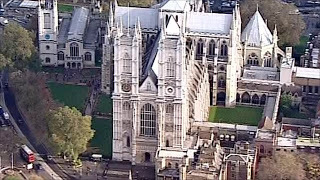
Westminster Abbey was founded in 960 and is the tallest medieval church in the country, reaching 102ft at the highest point of the nave; and its facade is the tallest of any English church, at 225ft. As the site of coronations since William the Conqueror in 1066, Westminster Abbey is closely associated with royalty throughout history. According to the Abbey's website, it has also been the venue for fifteen royal weddings, about to be sixteen. And since we love nothing more than tickling our "Fun with Wills and Kate" itch, here are some spectacular pictures of royal weddings at the Abbey from the past.
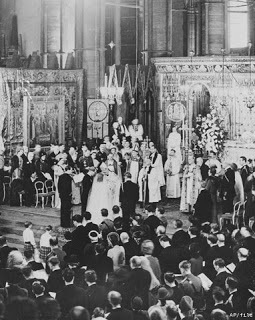
On November 20, 1947, Princess Elizabeth (later Queen Elizabeth II) married Prince Philip of Greece, who was made Duke of Edinburgh. They were the tenth royal couple to marry at the Abbey. Their wedding was broadcast by radio to the world. Rationing was still in effect and wartime austerity continued, so the wedding was a time for great national celebration.
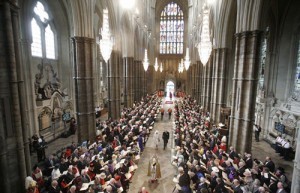
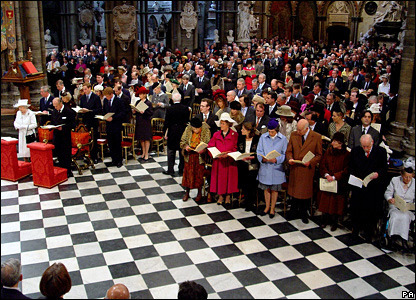
In 2007, Queen Elizabeth and Prince Philip celebrated their 60th wedding anniversary at a special ceremony in the Abbey. She is the first ever English monarch to achieve a diamond wedding celebration. in 2012, the Queen will observe her Diamond Jubilee, the 60th anniversary of her accession to the throne.
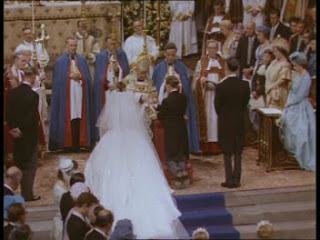
The Queen's sister Princess Margaret Rose (1930-2002) wed Anthony Armstrong-Jones in the Abbey on May 6, 1960. After two children, their marriage ended in divorce in 1978.
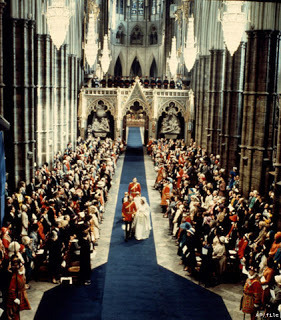
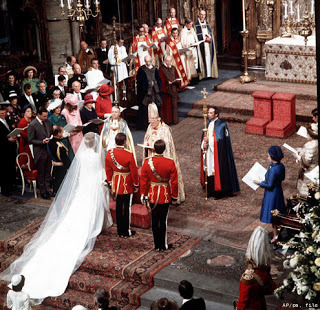
The Queen's only daughter, Anne, Princess Royal, married Captain Mark Phillips in Westminster Abbey on November 14, 1973. They have two children.
After divorcing Phillips in 1992, Anne married Timothy Laurence, in Scotland on December 12, 1992.
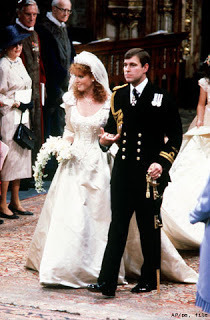
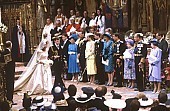
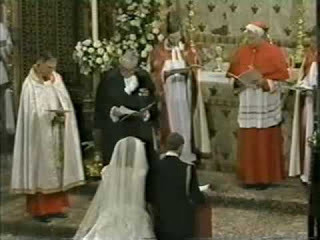
Prince Andrew married Sarah Ferguson on July 1986, They became the duke and duchess of York. They have two daughters, but separated in 1992 and divorced four years later.
We are awaiting the big day on Friday, April 29, for the next royal wedding at Westminster Abbey.

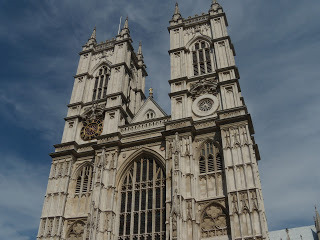

This Friday, the Abbey's 10 bells will ring out as William and Kate leave the royal wedding service. Westminster Abbey's bells only give a full peal on important royal or national occasions. It was sounded on the day of the Queen Mother's 100th birthday – August 4 2001 – and rung half muffled less than a year later after her funeral on April 9 2002. The 50th anniversary of the Second World War milestone V-E Day was commemorated by the bells in May 1995. Note: A full peal features a minimum of 5,000 different changes (or sequences) and lasts more than three hours.
Watch an interview with the royal florists, who will be creating an Avenue of Trees within the Abbey and using flowers from Windsor Great Park here.
Published on April 27, 2011 00:43
April 26, 2011
Partying with Jane Austen
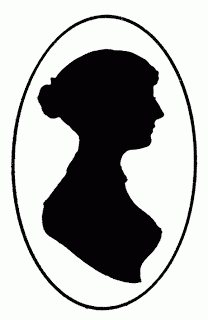
Yesterday I wrote about Jane Austen in London correcting proofs for Sense and Sensibility. She wrote her letter of April 25, 1811, to her sister Cassandra who was staying at Godmersham in Kent, their brother Edward's estate. Jane reports on the musical party given by her hosts in Sloane Street, her brother Henry and his wife Eliza, the former Comtesse de Feuillide.
"Our party went off extremely well. There were many solicitudes, alarms, and vexations, beforehand, of course, but at last everything was quite right. The rooms were dressed up with flowers, and looked very pretty. A glass for the mantlepiece was lent by the man who is making their own. Mr. Egerton and Mr. Walter came at half-past five, and the festivities began with a pair of very fine soals.
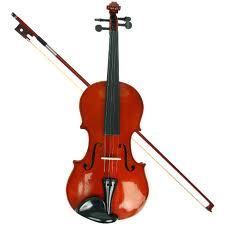
Yes, Mr. Walter -- for he postponed his leaving London on purpose -- which did not give much pleasure at the time, any more than the circumstance from which it rose -- his calling on Sunday and being asked by Henry to take the family dinner on that day, which he did; but it is all smoothed over now, and she likes him very well...."
Sloane Street today is a busy thoroughfare but in Jane Austen's day, it was on the edge of town, a newly developed residential area. In her letter to her sister Cassandra of April 18 , 1811, she mentioned that she and her sister-in-law Eliza would "walk to London" to buy decorations for Eliza's musical party. On April 25, she went on:"At half-past seven arrived the musicians in two hackney coaches, and by eight the lordly company began to appear. Among the earliest were George and Mary Cooke, and I spent the greater part of the evening very pleasantly with them. The drawing-room being soon hotter than we liked, we placed ourselves in the connecting passage, which was comparatively cool, and gave us all the advantage of the music at a pleasant distance, as well as that of the first view of every new comer.
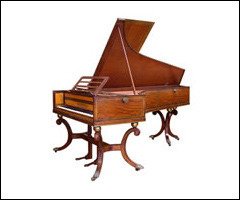 Finchcocks Musical Museum Collection
Finchcocks Musical Museum CollectionI was quite surrounded by acquaintance, especially gentlemen; and what with Mr. Hampson, Mr. Seymour, Mr. W. Knatchbull, Mr. Guillemarde, Mr. Cure, a Captain Simpson, brother to the Captain Simpson, besides Mr. Walter and Mr. Egerton, in addition to the Cookes, and Miss Beckford, and Miss Middleton, I had quite as much upon my hands as I could do.
Poor Miss B. has been suffering again from her old complaint, and looks thinner than ever. She certainly goes to Cheltenham the beginning of June. We were all delight and cordiality of course. Miss M. seems very happy, but has not beauty enough to figure in London.
Including everybody we were sixty-six -- which was considerably more than Eliza had expected, and quite enough to fill the back drawing-room and leave a few to be scattered about in the other and in the passage.
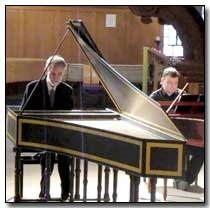 Finchcocks Musical Museum concert
Finchcocks Musical Museum concertThe music was extremely good. It opened (tell Fanny) with "Prike pe Parp pin praise pof Prapela"*; and of the other glees I remember, "In peace love tunes," "Rosabelle," "The Red Cross Knight," and "Poor Insect." Between the songs were lessons on the harp, or harp and pianoforte together; and the harp-player was Wiepart, whose name seems famous, though new to me. There was one female singer, a short Miss Davis, all in blue, bringing up for the public line, whose voice was said to be very fine indeed; and all the performers gave great satisfaction by doing what they were paid for, and giving themselves no airs. No amateur could be persuaded to do anything.
The house was not clear till after twelve. If you wish to hear more of it, you must put your questions, but I seem rather to have exhausted than spared the subject....
* Jane Austen and her niece Fanny, according to Deirdre Le Faye, had a nonsense vocabulary formed by putting the letter P in front of every word. The chorus words are actually, "Stike the Harp in Praise of Bragela."
More information on the songs mentioned can be found in the notes to Letter 71 in LaFaye's Jane Austen's Letters. In the Biogrphical Index, there is material on several of the people mentioned, some old friends of the Austen family.
Now you know what music to have at your next Jane Austen Musical Evening. To see more about Finchcocks Musical Museum, click here.
Published on April 26, 2011 00:00
April 25, 2011
Jane Austen: Sense and Sensibility
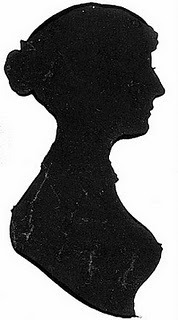 Jane Austen (1775-1817) wrote to her sister Cassandra on Thursday, April 25, 1811, from Sloane Street, London, where she was staying with her brother Henry and his wife Eliza, the former Comtesse de Feuillide. Jane was in London to correct proof pages for the publication of her first novel, Sense and Sensibility. Cassandra was at their brother Edward's estate at Godmersham, Kent.
Jane Austen (1775-1817) wrote to her sister Cassandra on Thursday, April 25, 1811, from Sloane Street, London, where she was staying with her brother Henry and his wife Eliza, the former Comtesse de Feuillide. Jane was in London to correct proof pages for the publication of her first novel, Sense and Sensibility. Cassandra was at their brother Edward's estate at Godmersham, Kent.Jane writes to her sister Cassandra of an assortment of subjects. Then she writes:
"No, indeed, I am never to busy to think of S. and S. I can no more forget it than a mother can forget her sucking child; and I am much obliged to you for your inquiries. I have had two sheets to correct, but the last only brings us to Willoughby's first appearance. Mrs. K. regrets in the most flattering manner that she must wait till May, but I have scarcely a hope of its being out in June. Henry does not neglect it; he has hurried the printer, and says he will see him again to-day. It will not stand still during his absence, it will be sent to Eliza.
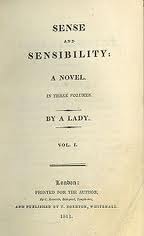
"The Incomes remain as they were, but I will get them altered if I can. I am very much gratified by Mrs. K's interest in it; and whatever may be the event of it as to my credit with her, sincerely wish her curiosity could be satisfied sooner than is now probable. I think she will like my Elinor, but cannot build on anything else..."
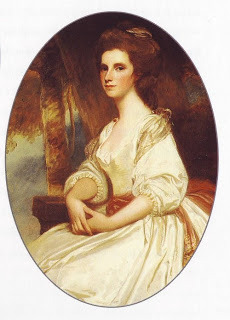 The Mrs. K. referred to in Austen's letter was Mrs. Catherine Knight, nee. Knatchbull. She and her husband Thomas "adopted" Jane's brother Edward and treated him as their own son, sending him on a grand tour of Europe and leaving him their property. Indeed a few years after her husband died in 1794, Mrs. Knight passed on the two estates of Godmersham in Kent and Chawton in Hampshire to Edward. Godmersham is today in private hands, but the Chawton property now is the home of the Chawton House Library and the Jane Austen House Museum, both well worth visiting on your next jaunt to Hampshire. The picture to the left is a portrait of Catherine Knatchbull Knight about the time of her marriage in 1779.For a closer look at the relationship of Jane Austen and Mrs. Knight, take a look at AustenBlog's comments.
The Mrs. K. referred to in Austen's letter was Mrs. Catherine Knight, nee. Knatchbull. She and her husband Thomas "adopted" Jane's brother Edward and treated him as their own son, sending him on a grand tour of Europe and leaving him their property. Indeed a few years after her husband died in 1794, Mrs. Knight passed on the two estates of Godmersham in Kent and Chawton in Hampshire to Edward. Godmersham is today in private hands, but the Chawton property now is the home of the Chawton House Library and the Jane Austen House Museum, both well worth visiting on your next jaunt to Hampshire. The picture to the left is a portrait of Catherine Knatchbull Knight about the time of her marriage in 1779.For a closer look at the relationship of Jane Austen and Mrs. Knight, take a look at AustenBlog's comments.Jane's suspicion that the novel would not be available even in June was prescient.
Sense and Sensibility was finally published 30 October, 1811.
Published on April 25, 2011 02:00
April 24, 2011
In the Garden With Kristine
Yesterday, I had just come in from a few sweaty hours out in the garden to find a new post on Margaret Evans Porter's blog, Periodic Pearls, showing her latest snowfall photos - just after she'd done some spring planting. Here in Southwest Florida (otherwise known as "the Sauna") it's already reaching 90 during the day. My garden is glorious and blooming and I thought I'd share some of my own snaps with you. I do not do this to boast, but rather to showcase the garden before everything that blooms and flowers withers away in the Zone 10 heat. Honestly, it's enough to make Lawrence of Arabia faint.

Yes, that's English lavender, doing quite well . . . . so far. Mexican petunia's grow against the fence. All of the rocks you see were unearthed by moi whilst planting. There's no real soil here, just lots of sandy dirt and many, many rocks. Sigh.

The Impatiens began as potted plants and now propagate themselves willy-nilly throughout my garden, back and front. I am not complaining.

Succulents, needless to say, do well in our climate
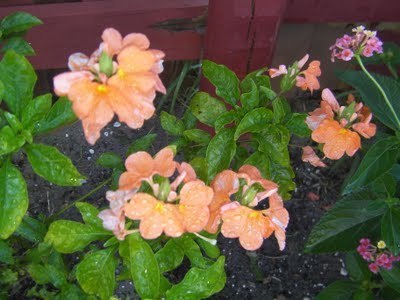
When I first began the garden, I'd bring home pots of lovely plants that would have suited an English garden, only to have them burned to a crisp. This year, I've admitted defeat and have given over the garden to tropical flowers.
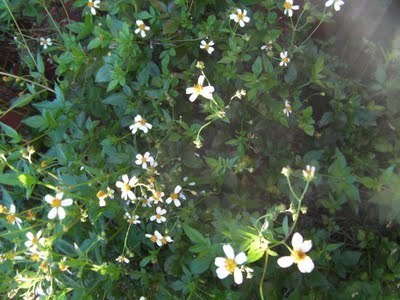
These Daisy's began as weeds. I finally stopped fighting them and now the bees have a new home.

Pentas + sun + poor soil = success
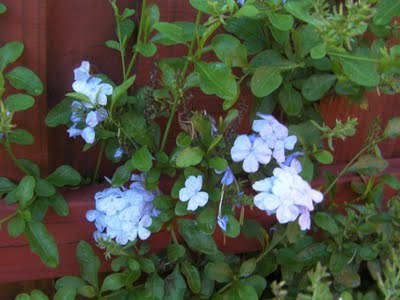
The Plumbago is in bloom

Even the roses are doing well

These are old English Heirloom Roses that I received through the post three years ago. Until this year, it looked like a rather sickly, snakey single shoot. Now, however, it's gone crazy and is climbing the fence, blooming and throwing out many thick shoots at its base. I can't tell you the exact name of the rose, as I threw the tag out in disgust last year. Patience is not one of my virtues.

A kind friend gave me two Frangipani's two years ago. He cut branches from his trees and told me to just stick them in the ground and they'd grow. One is yellow, the other pink. The pink, above, has never flowered, but it's gotten taller and has leaves. For a long time, both looked like nothing more than naked stalks stuck in the ground. My husband and son called them my "phallic symbols." However, she who laughs last laughs best - the yellow Frangipani has not only gotten taller, it's flowering.


Their fragrance is delicious - ripe nectarines.

Happy Easter!

Yes, that's English lavender, doing quite well . . . . so far. Mexican petunia's grow against the fence. All of the rocks you see were unearthed by moi whilst planting. There's no real soil here, just lots of sandy dirt and many, many rocks. Sigh.

The Impatiens began as potted plants and now propagate themselves willy-nilly throughout my garden, back and front. I am not complaining.

Succulents, needless to say, do well in our climate

When I first began the garden, I'd bring home pots of lovely plants that would have suited an English garden, only to have them burned to a crisp. This year, I've admitted defeat and have given over the garden to tropical flowers.

These Daisy's began as weeds. I finally stopped fighting them and now the bees have a new home.

Pentas + sun + poor soil = success

The Plumbago is in bloom

Even the roses are doing well

These are old English Heirloom Roses that I received through the post three years ago. Until this year, it looked like a rather sickly, snakey single shoot. Now, however, it's gone crazy and is climbing the fence, blooming and throwing out many thick shoots at its base. I can't tell you the exact name of the rose, as I threw the tag out in disgust last year. Patience is not one of my virtues.

A kind friend gave me two Frangipani's two years ago. He cut branches from his trees and told me to just stick them in the ground and they'd grow. One is yellow, the other pink. The pink, above, has never flowered, but it's gotten taller and has leaves. For a long time, both looked like nothing more than naked stalks stuck in the ground. My husband and son called them my "phallic symbols." However, she who laughs last laughs best - the yellow Frangipani has not only gotten taller, it's flowering.


Their fragrance is delicious - ripe nectarines.

Happy Easter!
Published on April 24, 2011 00:15
April 23, 2011
A Jane Digby Post by Guest Blogger Mary S. Lovell
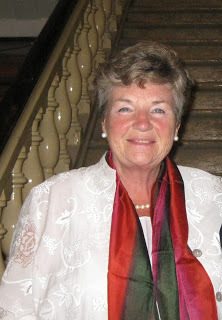 Author Mary S. Lovell
Author Mary S. Lovell
Recently, Victoria did a post on Jane Digby, the 19th century English adventuress, about which author Mary S. Lovell, Jane's biographer, sent us an email. We were delighted that Mary had found us via this blog. Mary is the author of many notable biographies: Bess of Hardwick, Beryl Markham, the Mitford Sisters, and Amelia Earhart. Her latest book, The Churchills: A Family at the Heart of History, will be released this month in the UK and in May in the US. You can read an in-depth review of the book that appeared in The Guardian here.
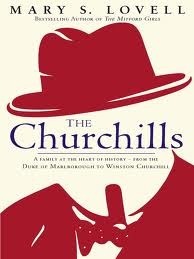
You can visit Mary's website here for news and information about all of her biographies. We were thrilled when Mary agreed to do a guest post for us on her own travels to Syria and along Jane's own path.
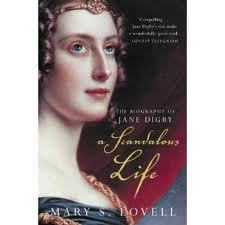
Mary writes:
I was fascinated to see your website marking Jane Digby's birthday last week, in which you also refer to the current situation in Syria.
When I began researching my biography of Jane in 1992 I went to Syria to track down her grave, and her house in Damascus (which I had been told had been demolished). The same source insisted that her diaries had been burned, but when some diligent research had turned those up intact, I decided I wanted to see the site of the demolished house for myself. It wasn't easy in those days to visit Syria; it was a closed country and tourism was unknown, so I had to describe myself as an amateur archaeologist to obtain a visa. I not only found the grave, but – with the help of my fantastic young guide and interpreter, Hussein Hinnawi – located what survived of Jane's house as well. It was then divided into flats the main part lived in by an old man whose parents bought it from Jane's stepson in the '30s.
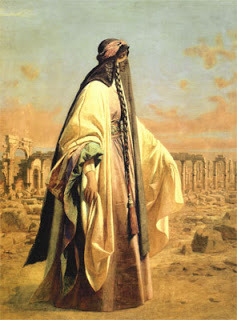 Lady Jane Digby El Mezrab
Lady Jane Digby El Mezrab
By Carl Haag 1862
copyright Tareq Rajab Museum
That first visit, soon after the Russians pulled out, was enough to make me fall in love with Syria and its friendly, courteous and hospitable people, its amazing historical sites, and - during my annual visits there ever since - I have seen it grow and change out of all recognition. It is the only country in the Middle East, now, that has any remaining traces of the fabulous Arabian Nights.
Until last year 2010, I led small groups to Syria every spring in Jane's adventurous footsteps, and often we had small adventures of our own. I have now given up leading groups, on the basis that it is as much as I can do to look after myself, but I still make a point of maintaining Jane's grave. The launch of my new book (The Churchills) in April 2011 means I shall have to travel to Syria later this year, in October in fact, which means I shall be spending my 70th birthday there, in an old palace converted into a lovely hotel, a short walk from the biblical 'Street called Straight', and from Jane's old home.
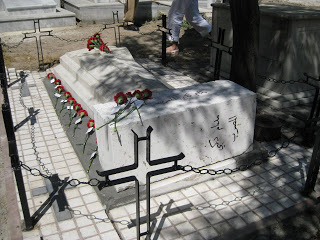
Jane's grave (see picture above), which is visited by large numbers of UK tourists now, is in the tiny Protestant Cemetery on the Airport Road. It is kept locked so if you go there you will have to find the Supervisor's house and give him a tip (baksheesh) of a few dollars to open the gate for you.
You might like to know that several friends of mine are visiting Syria at present and all report no signs of unrest despite what is on TV news. There is clearly a problem there, but if you are sensible and stick to the main areas of interest to visitors I see no reason why you should not still travel there. It would not prevent me.
Although I have written a number of books since my Digby biography, Jane Digby remains my favourite subject for sheer daring and romanticism.
With best wishes from Mary S Lovell
 Author Mary S. Lovell
Author Mary S. LovellRecently, Victoria did a post on Jane Digby, the 19th century English adventuress, about which author Mary S. Lovell, Jane's biographer, sent us an email. We were delighted that Mary had found us via this blog. Mary is the author of many notable biographies: Bess of Hardwick, Beryl Markham, the Mitford Sisters, and Amelia Earhart. Her latest book, The Churchills: A Family at the Heart of History, will be released this month in the UK and in May in the US. You can read an in-depth review of the book that appeared in The Guardian here.

You can visit Mary's website here for news and information about all of her biographies. We were thrilled when Mary agreed to do a guest post for us on her own travels to Syria and along Jane's own path.

Mary writes:
I was fascinated to see your website marking Jane Digby's birthday last week, in which you also refer to the current situation in Syria.
When I began researching my biography of Jane in 1992 I went to Syria to track down her grave, and her house in Damascus (which I had been told had been demolished). The same source insisted that her diaries had been burned, but when some diligent research had turned those up intact, I decided I wanted to see the site of the demolished house for myself. It wasn't easy in those days to visit Syria; it was a closed country and tourism was unknown, so I had to describe myself as an amateur archaeologist to obtain a visa. I not only found the grave, but – with the help of my fantastic young guide and interpreter, Hussein Hinnawi – located what survived of Jane's house as well. It was then divided into flats the main part lived in by an old man whose parents bought it from Jane's stepson in the '30s.
 Lady Jane Digby El Mezrab
Lady Jane Digby El Mezrab By Carl Haag 1862
copyright Tareq Rajab Museum
That first visit, soon after the Russians pulled out, was enough to make me fall in love with Syria and its friendly, courteous and hospitable people, its amazing historical sites, and - during my annual visits there ever since - I have seen it grow and change out of all recognition. It is the only country in the Middle East, now, that has any remaining traces of the fabulous Arabian Nights.
Until last year 2010, I led small groups to Syria every spring in Jane's adventurous footsteps, and often we had small adventures of our own. I have now given up leading groups, on the basis that it is as much as I can do to look after myself, but I still make a point of maintaining Jane's grave. The launch of my new book (The Churchills) in April 2011 means I shall have to travel to Syria later this year, in October in fact, which means I shall be spending my 70th birthday there, in an old palace converted into a lovely hotel, a short walk from the biblical 'Street called Straight', and from Jane's old home.

Jane's grave (see picture above), which is visited by large numbers of UK tourists now, is in the tiny Protestant Cemetery on the Airport Road. It is kept locked so if you go there you will have to find the Supervisor's house and give him a tip (baksheesh) of a few dollars to open the gate for you.
You might like to know that several friends of mine are visiting Syria at present and all report no signs of unrest despite what is on TV news. There is clearly a problem there, but if you are sensible and stick to the main areas of interest to visitors I see no reason why you should not still travel there. It would not prevent me.
Although I have written a number of books since my Digby biography, Jane Digby remains my favourite subject for sheer daring and romanticism.
With best wishes from Mary S Lovell
Published on April 23, 2011 00:34
April 22, 2011
Thos. Creevey and Life at the Royal Pavilion - Part Three
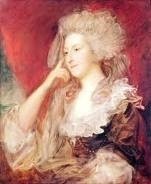 Mrs. Fitzherbert
Mrs. Fitzherbert
A Letter from Mrs. Creevey to Mr. Creevey in London.
". . . Oh, this wicked Pavillion! we were there till past one this morng., and it has kept me in bed with the headache till 12 to-day. . . . The invitation did not come to us till 9 o'clock: we went in Lord Thurloe's carriage but the Prince did not come out of the dining-room till 11. Till then our only companions were Lady Downshire and Mr. and Miss Johnstone—the former very goodnatured and amiable. . . . When the Prince appeared, I instantly saw he had got more wine than usual, and it was still more evident that the German Baron was extremely drunk. The Prince came up and were in fear of being too late; sat by me—introduced McMahon to me, and talked a great deal about Mrs. Fitzherbert—said she had been 'delighted' with my note, and wished much to see me. He asked her 'When?'—and he said her answer was —' Not till you are gone, and I can see her comfortably.' I suppose this might be correct, for Mac told me he had been 'worrying her to death' all the morning.
"It appears to me I have found a true friend in Mac* He is even more foolish than I expected; but I shall be disappointed if, even to you, he does not profess himself my devoted admirer.
"Afterwards the Prince led all the party to the table where the maps lie, to see him shoot with an air-gun at a target placed at the end of the room. He did it very skilfully, and wanted all the ladies to attempt it. The girls and I excused ourselves on account of our short sight; but Lady Downshire hit a fiddler in the dining-room, Miss Johnstone a door and Bloomfield the ceiling. ... I soon had enough of this, and retired to the fire with Mac ... At last a waltz was played by the band, and the Prince offered to waltz with Miss Johnstone, but very quietly, and once round the table made him giddy, so of course it was proper for his partner to be giddy too; but he cruelly only thought of supporting himself, so she reclined on the Baron."
Sunday, Nov. 3, 1805. "And so I amuse you by my histories. Well! I am glad of it, and it encourages me to go on; and yet I can tell you I could tire of such horrors as I have had the last 3 evenings. I nevertheless estimate them as you do, and am quite disposed to persevere. The second evening was the worst. We were in the diningroom (a comfortless place except for eating and drinking in), and sat in a circle round the fire, which (to indulge you with 'detail') was thus arranged. Mrs. F(itzherbert] in the chimney corner (but not knitting), next to her Lady Downshire—then Mrs. Creevey— then Geoff—then Dr. [erased]—then Savory—then Warner—then Day, vis-a-vis his mistress, and most of the time snoring like a pig and waking for nothing better than a glass of water, which he call'd for, hoping, I think, to be offered something better. . .
Last night was better; it was the same party only instead of Savory, a Col. or Major Watley [?] of the
Gloster Militia, and the addition of Mrs. Morant, an old card-playing woman. . . . Mrs. Fitz shone last
night very much in a sketch she gave me of the history of a very rich Russian woman of quality who is coming
to Lord Berkeley's house. She has been long in England, and is I suppose generally known in London,
though new to me. She was a married woman with children, and of great consequence at the court of
Petersburgh when Lord Whitworth was there some years ago. He was poor and handsome—she rich
and in love with him, and tired of a very magnificent husband to whom she had been married at 14 years
old. In short, she kept my Lord, and spent immense sums in doing so and gratifying his great extravagance.
In the midst of all this he return'd to England, but they corresponded, and she left her husband and her
country to come to him, expecting to marry him—got as far as Berlin, and there heard he was married to
the Duchess of Dorset.
"She was raving mad for some time, and Mrs. F. describes her as being often nearly so now, but at other times most interesting, and most miserable. Her husband and children come to England to visit her, and Mrs. F. says she is an eternal subject of remorse to Lord Whitworth, whom she [Mrs. F] spoke of in warm terms as 'a monster,' and said she could tell me far more to make me think so. The story sometimes hit upon points that made her blush and check herself, which was to me not the least interesting part of it. . . . She laughed more last night than ever at the Johnstones—said he was a most vulgar man, but seem'd to give him credit for his good nature to his sister and his generosity. The Baron is preparing a phantasmagoria at the Pavillion, and she [Mrs. F] laughs at what he may do with Miss Johnstone in a dark room."
* The Right Hon. John Macmahon, Private Secretary and Keeper of the Privy Purse to the Prince of Wales. Died in 1817.
 Mrs. Fitzherbert
Mrs. FitzherbertA Letter from Mrs. Creevey to Mr. Creevey in London.
". . . Oh, this wicked Pavillion! we were there till past one this morng., and it has kept me in bed with the headache till 12 to-day. . . . The invitation did not come to us till 9 o'clock: we went in Lord Thurloe's carriage but the Prince did not come out of the dining-room till 11. Till then our only companions were Lady Downshire and Mr. and Miss Johnstone—the former very goodnatured and amiable. . . . When the Prince appeared, I instantly saw he had got more wine than usual, and it was still more evident that the German Baron was extremely drunk. The Prince came up and were in fear of being too late; sat by me—introduced McMahon to me, and talked a great deal about Mrs. Fitzherbert—said she had been 'delighted' with my note, and wished much to see me. He asked her 'When?'—and he said her answer was —' Not till you are gone, and I can see her comfortably.' I suppose this might be correct, for Mac told me he had been 'worrying her to death' all the morning.
"It appears to me I have found a true friend in Mac* He is even more foolish than I expected; but I shall be disappointed if, even to you, he does not profess himself my devoted admirer.
"Afterwards the Prince led all the party to the table where the maps lie, to see him shoot with an air-gun at a target placed at the end of the room. He did it very skilfully, and wanted all the ladies to attempt it. The girls and I excused ourselves on account of our short sight; but Lady Downshire hit a fiddler in the dining-room, Miss Johnstone a door and Bloomfield the ceiling. ... I soon had enough of this, and retired to the fire with Mac ... At last a waltz was played by the band, and the Prince offered to waltz with Miss Johnstone, but very quietly, and once round the table made him giddy, so of course it was proper for his partner to be giddy too; but he cruelly only thought of supporting himself, so she reclined on the Baron."
Sunday, Nov. 3, 1805. "And so I amuse you by my histories. Well! I am glad of it, and it encourages me to go on; and yet I can tell you I could tire of such horrors as I have had the last 3 evenings. I nevertheless estimate them as you do, and am quite disposed to persevere. The second evening was the worst. We were in the diningroom (a comfortless place except for eating and drinking in), and sat in a circle round the fire, which (to indulge you with 'detail') was thus arranged. Mrs. F(itzherbert] in the chimney corner (but not knitting), next to her Lady Downshire—then Mrs. Creevey— then Geoff—then Dr. [erased]—then Savory—then Warner—then Day, vis-a-vis his mistress, and most of the time snoring like a pig and waking for nothing better than a glass of water, which he call'd for, hoping, I think, to be offered something better. . .
Last night was better; it was the same party only instead of Savory, a Col. or Major Watley [?] of the
Gloster Militia, and the addition of Mrs. Morant, an old card-playing woman. . . . Mrs. Fitz shone last
night very much in a sketch she gave me of the history of a very rich Russian woman of quality who is coming
to Lord Berkeley's house. She has been long in England, and is I suppose generally known in London,
though new to me. She was a married woman with children, and of great consequence at the court of
Petersburgh when Lord Whitworth was there some years ago. He was poor and handsome—she rich
and in love with him, and tired of a very magnificent husband to whom she had been married at 14 years
old. In short, she kept my Lord, and spent immense sums in doing so and gratifying his great extravagance.
In the midst of all this he return'd to England, but they corresponded, and she left her husband and her
country to come to him, expecting to marry him—got as far as Berlin, and there heard he was married to
the Duchess of Dorset.
"She was raving mad for some time, and Mrs. F. describes her as being often nearly so now, but at other times most interesting, and most miserable. Her husband and children come to England to visit her, and Mrs. F. says she is an eternal subject of remorse to Lord Whitworth, whom she [Mrs. F] spoke of in warm terms as 'a monster,' and said she could tell me far more to make me think so. The story sometimes hit upon points that made her blush and check herself, which was to me not the least interesting part of it. . . . She laughed more last night than ever at the Johnstones—said he was a most vulgar man, but seem'd to give him credit for his good nature to his sister and his generosity. The Baron is preparing a phantasmagoria at the Pavillion, and she [Mrs. F] laughs at what he may do with Miss Johnstone in a dark room."
* The Right Hon. John Macmahon, Private Secretary and Keeper of the Privy Purse to the Prince of Wales. Died in 1817.
Published on April 22, 2011 01:06
April 21, 2011
Thos. Creevey and Life at the Royal Pavilion - Part Two
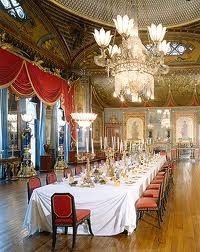
"I suppose the Courts or houses of Princes are all alike in one thing, viz., that in attending them you lose your liberty. After one month was gone by, you fell naturally and of course into the ranks, and had to reserve your observations till you were asked for them. These royal invitations are by no means calculated to reconcile one to a Court. To be sent for half an hour before dinner, or perhaps in the middle of one's own, was a little too humiliating to be very agreeable.
". . . Lord Hutchinson * was a great feature at the Pavilion. He lived in the house, or rather the one adjoining it, and within the grounds. ... As a military man he was a great resource at that time, as we were in the midst of expectations about the Austrians and Buonaparte, and the battle which we all knew would so soon take place between them. It was a funny thing to hear the Prince, when the battle had taken place, express the same opinion as was given in the London Government newspapers, that it was all over with the French—that they were all sent to the devil, and the Lord knows what. Maps were got out to satisfy everybody as to the precise ground where the battle had been fought and the route by which the French had retreated. While these operations were going on in one window of the Pavilion, Lord Hutchinson took me privately to another, when he put into my hand his own private dispatch from Gordon, then Secretary to the Commander-in-Chief, giving him the true account of the battle of Austerlitz, with the complete victory of the French. This news, unaccountable as it may appear, was repeated day after day at the Pavilion for nearly a week; and when the truth began at last to make its appearance in the newspapers, the Prince puts them all in his pockets, so that no paper was forthcoming at the Pavilion, instead of half-a-dozen, the usual number. . . . We used to dine pretty punctually at six, the average number being about sixteen. . . . Mrs. Fitzherbert always dined there, and mostly one other lady—Lady Downshire very often, sometimes Lady Clare or Lady Berkeley or Mrs. Creevey. Mrs. Fitzherbert was a great card-player, and played every night. The Prince never touched a card, but was occupied in talking to his guests, and very much in listening to and giving directions to the band. At 12 o'clock punctually the band stopped, and sandwiches and wine and water handed about, and shortly after the Prince made a bow and we all dispersed.
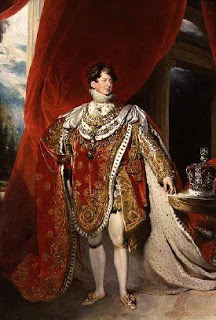
"I had heard a great deal of the Prince's drinking, but, during the time that I speak of, I never saw him the least drunk but once, and I was myself pretty much the occasion of it. We were dining at the Pavilion, and poor Fonblanque, a dolorous fop of a lawyer, and a member of Parliament too, was one of the guests. After drinking some wine, I could not resist having some jokes at Fonblanque's expense, which the Prince encouraged greatly. I went on and invented stories about speeches Fonblanque had made in Parliament, which were so pathetic as to have affected his audience to tears, all of which inventions of mine Fonblanque denied to be true with such overpowering gravity that the Prince said he should die of it if I did not stop. ... In the evening, at about ten or eleven o'clock, he said he would go to the ball at the Castle, and said I should go with him. So I went in his coach, and he entered the room with his arm through mine, everybody standing and getting upon benches to see him. He was certainly tipsey, and so, of course, was I, but not much, for I well remember his taking me up to Mrs. Creevey and her daughters, and telling them he had never spent a pleasanter day in his life, and that ' Creevey had been very great.' He used to drink a great quantity of wine at dinner, and was very fond of making any newcomer drunk by drinking wine with him very frequently, always recommending his strongest wines, and at last some remarkably strong old brandy which he called Diabolino.
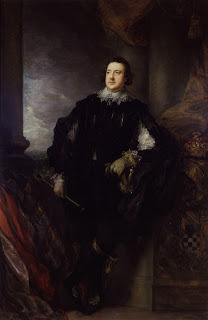 The 11th Duke of Norfolk
The 11th Duke of Norfolk "It used to be the Duke of Norfolk's custom to come over every year from Arundel to pay his respects to the Prince and to stay two days at Brighton, both of which he always dined at the Pavilion. In the year 1804, upon this annual visit, the Prince had drunk so much as to be made very seriously ill by it, so that in 1805 (the year that I was there) when the Duke came, Mrs. Fitzherbert, who was always the Prince's best friend, was very much afraid of his being again made ill, and she persuaded the Prince to adopt different stratagems to avoid drinking with the Duke. I dined there on both days, and letters were brought in each day after dinner to the Prince, which he affected to consider of great importance, and so went out to answer them, while the Duke of Clarence went on drinking with the Duke of Norfolk. But on the second day this joke was carried too far, and in the evening the Duke of Norfolk showed he was affronted. The Prince took me aside and said—' Stay after everyone is gone tonight. The Jockey's got sulky, and I must give him a broiled bone to get him in good humour again.' So of course I stayed, and about one o'clock the Prince of Wales and Duke of Clarence, the Duke of Norfolk sat down a dinner of broiled bones.
* Brother of the 1st Earl of Donoughmore; a general officer, succeeded Sir Ralph Abercromby in command of the army in Egypt, and was raised to the peerage in 1801, with a pension of £2000. Died in 1832.
Part Three Coming Soon!
Published on April 21, 2011 00:45
April 20, 2011
Thos. Creevey and Life at the Royal Pavilion - Part One
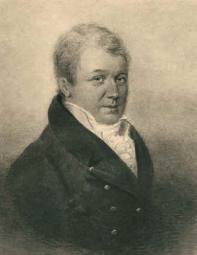 Thomas Creevey
Thomas Creevey
"It was in 1804 when I first began to take a part in the House of Commons, at which time the Prince of Wales was a most warm and active partizan of Mr. Fox and the Opposition. It was then that the Prince began first to notice me, and to stop his horse and talk with me when he met me in the streets; but I recollect only one occasion, in that or the succeeding year, that I dined at Carlton House, and that was with a party of the Opposition, to whom he gave various dinners during that spring. On that occasion Lord Dundas and Calcraft sat at the top and bottom of the table, the Prince in the middle at one side, with the Duke of Clarence next to him; Fox, Sheridan and about 30 opposition members of both Houses making the whole party. We walked about the garden before dinner without our hats.
"The only thing that made an impression upon me in favour of the Prince that day (always excepting his excellent manners and appearance of good humour) was his receiving a note during dinner which he flung across the table to Fox and asked if he must not answer it, which Fox assented to; and then, without the slightest fuss, the Prince left his place, went into another room and wrote an answer, which he brought to Fox for his approval, and when the latter said it was quite right, tne Prince seemed delighted, which I thought very pretty in him, and a striking proof of Fox's influence over him.
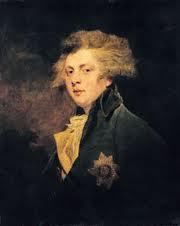 George IV as Prince of Wales by Reynolds "During dinner he was very gracious, funny and agreeable, but after dinner he took to making speeches, and was very prosy as well as highly injudicious. He made a long harangue in favour of the Catholics and took occasion to tell us that his brother William and himself were the only two of his family who were not Germans—this too in a company which was, most of them, barely known to him. Likewise I remember his halloaing to Sir Charles Bamfyld at the other end of the table, and asking him if he had seen Mother Windsor lately. I brought Lord Howick and George Walpole home at night in my coach, and so ended that day.
George IV as Prince of Wales by Reynolds "During dinner he was very gracious, funny and agreeable, but after dinner he took to making speeches, and was very prosy as well as highly injudicious. He made a long harangue in favour of the Catholics and took occasion to tell us that his brother William and himself were the only two of his family who were not Germans—this too in a company which was, most of them, barely known to him. Likewise I remember his halloaing to Sir Charles Bamfyld at the other end of the table, and asking him if he had seen Mother Windsor lately. I brought Lord Howick and George Walpole home at night in my coach, and so ended that day.
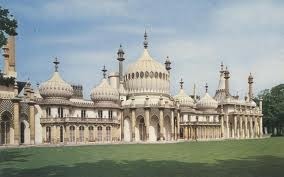 The Royal Pavilion, Brighton"At the beginning of September,1805, Mrs. Creevey and myself with her daughters went to Brighton to spend the autumn there, the Prince then living at the Pavilion. I think it was the first, or at furthest the second, day after our arrival, when my two eldest daughters and myself were walking on the Steyne, and the Prince, who was sitting talking to old Lady Clermont, having perceived me, left her and came up to speak to me, when I presented my daughters to him. He was very gracious to us all and hoped he should see me shortly at dinner. In two or three days from this time I received an invitation to dine at the Pavilion. . . . Mrs. Fitzherbert, whom I had never been in a room with before, sat on one side of the Prince, and the Duke of Clarence on the other. ... In the course of the evening the Prince took me up to the card table where Mrs. Fitzherbert was playing, and said—' Mrs. Fitzherbert, I wish you would call upon Mrs. Creevey, and say from me I shall be happy to see her here.' Mrs. Fitzherbert did call accordingly, and altho' she and Mrs. Creevey had never seen each other before, an acquaintance began that soon grew into a very sincere and agreeable friendship, which lasted the remainder of Mrs. Creevey's life. . . .
The Royal Pavilion, Brighton"At the beginning of September,1805, Mrs. Creevey and myself with her daughters went to Brighton to spend the autumn there, the Prince then living at the Pavilion. I think it was the first, or at furthest the second, day after our arrival, when my two eldest daughters and myself were walking on the Steyne, and the Prince, who was sitting talking to old Lady Clermont, having perceived me, left her and came up to speak to me, when I presented my daughters to him. He was very gracious to us all and hoped he should see me shortly at dinner. In two or three days from this time I received an invitation to dine at the Pavilion. . . . Mrs. Fitzherbert, whom I had never been in a room with before, sat on one side of the Prince, and the Duke of Clarence on the other. ... In the course of the evening the Prince took me up to the card table where Mrs. Fitzherbert was playing, and said—' Mrs. Fitzherbert, I wish you would call upon Mrs. Creevey, and say from me I shall be happy to see her here.' Mrs. Fitzherbert did call accordingly, and altho' she and Mrs. Creevey had never seen each other before, an acquaintance began that soon grew into a very sincere and agreeable friendship, which lasted the remainder of Mrs. Creevey's life. . . .
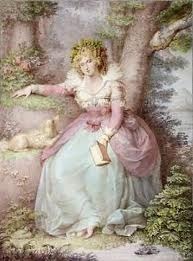 Mrs. Fitzherbert by Cosway". . . Immediately after this first visit from Mrs. Fitzherbert, Mrs. Creevey and her daughters became invited with myself to the Prince's parties at the Pavilion, and till the first week in January—a space of about four months—except a few days when the Prince went to see the King at Weymouth, and a short time that I was in London in November, there was not a day we were not at the Pavilion, I dining there always once or twice a week, Mrs. Creevey frequently dining with me likewise, but in the evening we were always there.
Mrs. Fitzherbert by Cosway". . . Immediately after this first visit from Mrs. Fitzherbert, Mrs. Creevey and her daughters became invited with myself to the Prince's parties at the Pavilion, and till the first week in January—a space of about four months—except a few days when the Prince went to see the King at Weymouth, and a short time that I was in London in November, there was not a day we were not at the Pavilion, I dining there always once or twice a week, Mrs. Creevey frequently dining with me likewise, but in the evening we were always there.
"During these four months the Prince behaved with the greatest good humour as well as kindness to us all. He was always merry and full of his jokes, and any one would have said he was really a very happy man. Indeed I have heard him say repeatedly during that time that he never should be so happy, when King, as he was then.
Part Two Tomorrow!

 Thomas Creevey
Thomas Creevey "It was in 1804 when I first began to take a part in the House of Commons, at which time the Prince of Wales was a most warm and active partizan of Mr. Fox and the Opposition. It was then that the Prince began first to notice me, and to stop his horse and talk with me when he met me in the streets; but I recollect only one occasion, in that or the succeeding year, that I dined at Carlton House, and that was with a party of the Opposition, to whom he gave various dinners during that spring. On that occasion Lord Dundas and Calcraft sat at the top and bottom of the table, the Prince in the middle at one side, with the Duke of Clarence next to him; Fox, Sheridan and about 30 opposition members of both Houses making the whole party. We walked about the garden before dinner without our hats.
"The only thing that made an impression upon me in favour of the Prince that day (always excepting his excellent manners and appearance of good humour) was his receiving a note during dinner which he flung across the table to Fox and asked if he must not answer it, which Fox assented to; and then, without the slightest fuss, the Prince left his place, went into another room and wrote an answer, which he brought to Fox for his approval, and when the latter said it was quite right, tne Prince seemed delighted, which I thought very pretty in him, and a striking proof of Fox's influence over him.
 George IV as Prince of Wales by Reynolds "During dinner he was very gracious, funny and agreeable, but after dinner he took to making speeches, and was very prosy as well as highly injudicious. He made a long harangue in favour of the Catholics and took occasion to tell us that his brother William and himself were the only two of his family who were not Germans—this too in a company which was, most of them, barely known to him. Likewise I remember his halloaing to Sir Charles Bamfyld at the other end of the table, and asking him if he had seen Mother Windsor lately. I brought Lord Howick and George Walpole home at night in my coach, and so ended that day.
George IV as Prince of Wales by Reynolds "During dinner he was very gracious, funny and agreeable, but after dinner he took to making speeches, and was very prosy as well as highly injudicious. He made a long harangue in favour of the Catholics and took occasion to tell us that his brother William and himself were the only two of his family who were not Germans—this too in a company which was, most of them, barely known to him. Likewise I remember his halloaing to Sir Charles Bamfyld at the other end of the table, and asking him if he had seen Mother Windsor lately. I brought Lord Howick and George Walpole home at night in my coach, and so ended that day.
 The Royal Pavilion, Brighton"At the beginning of September,1805, Mrs. Creevey and myself with her daughters went to Brighton to spend the autumn there, the Prince then living at the Pavilion. I think it was the first, or at furthest the second, day after our arrival, when my two eldest daughters and myself were walking on the Steyne, and the Prince, who was sitting talking to old Lady Clermont, having perceived me, left her and came up to speak to me, when I presented my daughters to him. He was very gracious to us all and hoped he should see me shortly at dinner. In two or three days from this time I received an invitation to dine at the Pavilion. . . . Mrs. Fitzherbert, whom I had never been in a room with before, sat on one side of the Prince, and the Duke of Clarence on the other. ... In the course of the evening the Prince took me up to the card table where Mrs. Fitzherbert was playing, and said—' Mrs. Fitzherbert, I wish you would call upon Mrs. Creevey, and say from me I shall be happy to see her here.' Mrs. Fitzherbert did call accordingly, and altho' she and Mrs. Creevey had never seen each other before, an acquaintance began that soon grew into a very sincere and agreeable friendship, which lasted the remainder of Mrs. Creevey's life. . . .
The Royal Pavilion, Brighton"At the beginning of September,1805, Mrs. Creevey and myself with her daughters went to Brighton to spend the autumn there, the Prince then living at the Pavilion. I think it was the first, or at furthest the second, day after our arrival, when my two eldest daughters and myself were walking on the Steyne, and the Prince, who was sitting talking to old Lady Clermont, having perceived me, left her and came up to speak to me, when I presented my daughters to him. He was very gracious to us all and hoped he should see me shortly at dinner. In two or three days from this time I received an invitation to dine at the Pavilion. . . . Mrs. Fitzherbert, whom I had never been in a room with before, sat on one side of the Prince, and the Duke of Clarence on the other. ... In the course of the evening the Prince took me up to the card table where Mrs. Fitzherbert was playing, and said—' Mrs. Fitzherbert, I wish you would call upon Mrs. Creevey, and say from me I shall be happy to see her here.' Mrs. Fitzherbert did call accordingly, and altho' she and Mrs. Creevey had never seen each other before, an acquaintance began that soon grew into a very sincere and agreeable friendship, which lasted the remainder of Mrs. Creevey's life. . . .
 Mrs. Fitzherbert by Cosway". . . Immediately after this first visit from Mrs. Fitzherbert, Mrs. Creevey and her daughters became invited with myself to the Prince's parties at the Pavilion, and till the first week in January—a space of about four months—except a few days when the Prince went to see the King at Weymouth, and a short time that I was in London in November, there was not a day we were not at the Pavilion, I dining there always once or twice a week, Mrs. Creevey frequently dining with me likewise, but in the evening we were always there.
Mrs. Fitzherbert by Cosway". . . Immediately after this first visit from Mrs. Fitzherbert, Mrs. Creevey and her daughters became invited with myself to the Prince's parties at the Pavilion, and till the first week in January—a space of about four months—except a few days when the Prince went to see the King at Weymouth, and a short time that I was in London in November, there was not a day we were not at the Pavilion, I dining there always once or twice a week, Mrs. Creevey frequently dining with me likewise, but in the evening we were always there."During these four months the Prince behaved with the greatest good humour as well as kindness to us all. He was always merry and full of his jokes, and any one would have said he was really a very happy man. Indeed I have heard him say repeatedly during that time that he never should be so happy, when King, as he was then.
Part Two Tomorrow!
Published on April 20, 2011 01:38
April 19, 2011
In Memoriam
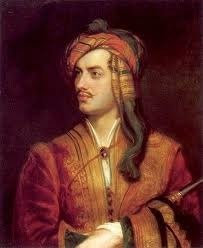
George Gordon Byron, 6th Baron Byron, later George Gordon Noel, 6th Baron Byron, FRS 22 January 1788 - 19 April 1824
Published on April 19, 2011 03:07
The Art Needlepoint Company Offers Cruise on the Queen Mary 2
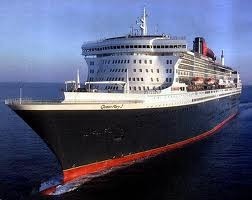
The Art Needlepoint Company was founded on the simple idea that art, like good design, should be available to everyone. Their canvasses represent a large variety of artists from nearly all centuries and genres. With a myriad of thread and stitch choices, stitchers can unleash their creativity to make each canvas their own.
Now, stitchers can come together on the Company's first cruise aboard the Queen Mary 2 sailing from NYC on July 27th 2011 on a six day crossing – a time for unwinding and relaxation and when the weather is most often ideal to travel across the pond. Lorna Bateman, one of England's better known embroidery and needlepoint instructors will be onboard and there will be technique instruction every day with chances beyond class time to stitch together and learn from one another. A variety of topics will be covered. The cruise vacation will culminate at the Royal School of Needlework in London and for those who wish to stay on for an extra few days, there is a planned a tour of the tapestries at the Victoria and Albert Museum.
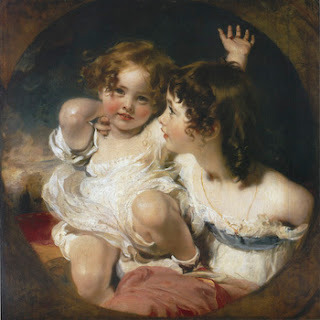 The Calmady Children by Sir Thomas LawrenceDuring the cruise, stitchers will learn how to stitch a face, enliven an abstract image with a variety of stitches or give dimension to a landscape by shading with thread. We'll teach them how to select a masterpiece canvas to match their skill level or learn how and why to select fiber best suited for particular canvases. The Art Needlepoint Company's cruises and retreats have an educational component to them; both an art history education or cultural review of a particular destination (cruise) as well as an educational component of needlepoint focused on stitches and ways to interpret paintings with threads.
The Calmady Children by Sir Thomas LawrenceDuring the cruise, stitchers will learn how to stitch a face, enliven an abstract image with a variety of stitches or give dimension to a landscape by shading with thread. We'll teach them how to select a masterpiece canvas to match their skill level or learn how and why to select fiber best suited for particular canvases. The Art Needlepoint Company's cruises and retreats have an educational component to them; both an art history education or cultural review of a particular destination (cruise) as well as an educational component of needlepoint focused on stitches and ways to interpret paintings with threads.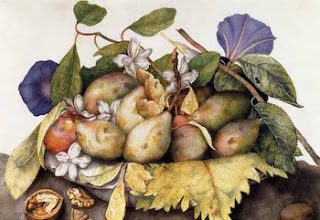 Plums, Walnuts and Jasmine
Plums, Walnuts and JasmineThe QM2 is a trip of a lifetime. The Queen Mary has many beautiful attributes as well as a wide variety of activities available on board for people to do in addition to needlepoint. The ship sets the tone for the experience. It is a gorgeous vessel and we hope that everyone who joins us completes or near to completes a gorgeous canvas! If any one would like more details on what canvases are offered or course syllabus they are welcome to phone or email us. A second cruise is planned for December on The Ruby Princess which travels the Eastern Caribbean – Princess' private island, St. Martin, St. Thomas, Grand Turk.
In the works for 2011 are several one-two or three day retreats for those who want to share that needlepoint community experience but prefer a shorter, land-based adventure. As Doreen Finkle explains, "To replicate the cruise experience on land, all of our retreats will be based at spas and luxury hotels around the country. For both the cruises and retreats, particpants are welcome to bring a canvas from home. However, we will have a special selection of canvases, keyed to either the cruise or retreat theme, which participants can view and select at the Art Needlepoint site.
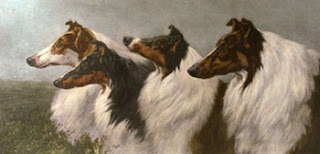 Collies"This year we are planning a retreat in Raleigh NC . This will be a retreat in the fall. We will have one day at the Raleigh Museum of Art with a specially developed tour of the American painters collection and modern paintings with another day of classes. The canvases we would like people to bring with them to class will be either a portrait (American painter) a landscape (American painter) or a modern canvas. We will discuss how to stitch faces and skin so that they are realistic, as well as other technique points. There will always be a one on one opportunity to ask for specific assistance on whatever the individual requests.
Collies"This year we are planning a retreat in Raleigh NC . This will be a retreat in the fall. We will have one day at the Raleigh Museum of Art with a specially developed tour of the American painters collection and modern paintings with another day of classes. The canvases we would like people to bring with them to class will be either a portrait (American painter) a landscape (American painter) or a modern canvas. We will discuss how to stitch faces and skin so that they are realistic, as well as other technique points. There will always be a one on one opportunity to ask for specific assistance on whatever the individual requests."We also have a retreat planned for the late summer in Boston. We will gather together at the colonnade hotel, which is in walking distance to the MFA, Boston where we will have a private specially developed tour of their magnificent newly built Art of the Americas wing. Our class format will follow the day after the tour and will focus on portraits and landscapes. We will talk about techniques for creating light and dark with different threads, as well as rendering realistic faces and skin. There will always be a one on one opportunity to ask for specific assistance on whatever the individual requests."
For further cruise details, contact Doreen at the Art Needlepoint Company, or by telephone (978) 226-8271.
Followers of Number One London will receive a 10% discount on any canvases or kits purchased. Use code "London" when placing your order!
Published on April 19, 2011 00:00
Kristine Hughes's Blog
- Kristine Hughes's profile
- 6 followers
Kristine Hughes isn't a Goodreads Author
(yet),
but they
do have a blog,
so here are some recent posts imported from
their feed.



